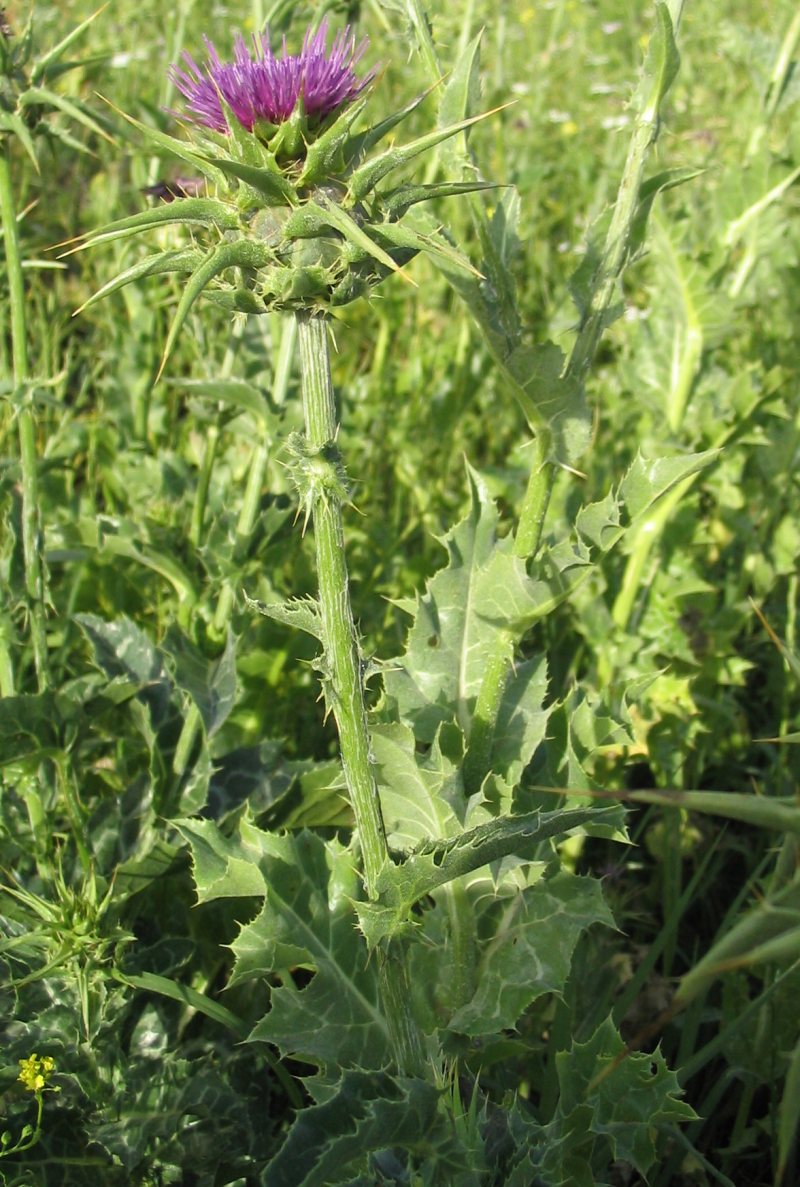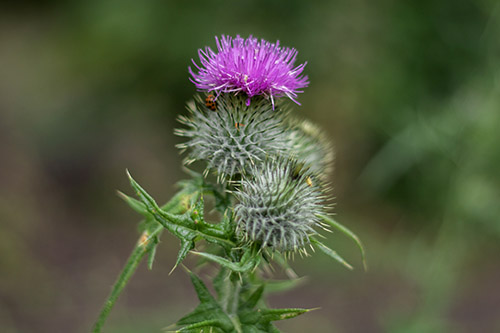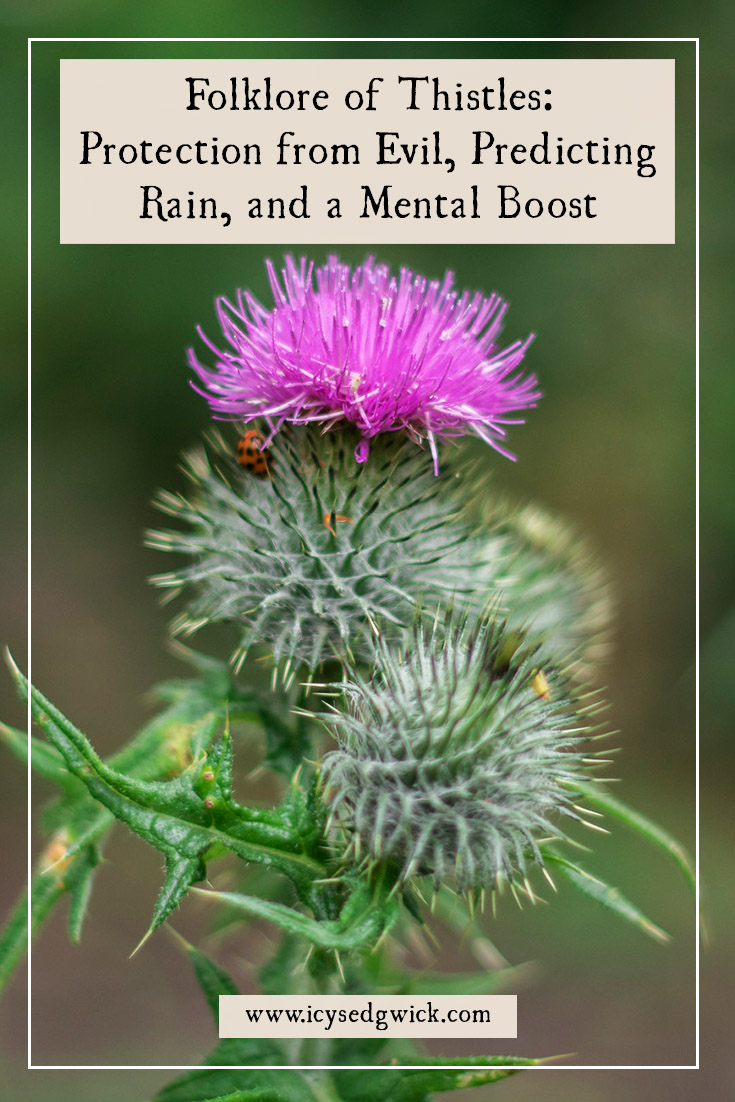Thistles aren’t a single plant. The term ‘thistle’ refers to a group of plants in the Asteraceae family. The main thing they have in common is the fact they’ve got prickles to try to stop herbivores from eating them.
Three specific groups, the Carduus, Cirsium and Onopordum, are usually the plants people mean when they say thistles.
And yes, it gets confusing pretty quickly. As we’re focusing on folklore, we’ll look at what the lore says, rather than getting bogged down in botanical differences. But this post isn’t intended to help you identify plants, just to understand how people once thought of them!
In the nettles post, I mentioned the 1959 Weeds Act, in which parliament required landowners to prevent the spread of dock leaves. Turns out the Act also applies to both spear and creeping thistle! (And ragwort, but that’s beyond this post) That makes thistles a great addition to this Unwanted Plants series.
Let’s find out how thistles can banish evil, drive away gloomy thoughts, and protect your home!
Protective Thistles
It’s perhaps a little obvious that thistles would fall under the heading of ‘protective’. Astrologer William Lilly asserted that all manner of thistles fell under Mars’ rulership (1647: 67). This made the plants good at defending the self – after all, they’d developed prickles to stop animals from eating them.
Indeed, one legend sees thistles help to protect Scotland, and thus become the national flower. According to one version of the legend, Danish invaders at Stirling Castle stepped on thistles around the perimeter, alerting the defenders with their howls of pain (Baker 2011 [1969]: 148).

Another version of the story sees a Norse army land in Scotland in the 13th century. They planned to ambush the Scots and removed their shoes so as to be stealthy in their approach. One of the invaders stood on a thistle in the dark and his cry alerted the Scots. The ambush fell apart and the Scots thrashed the invaders (Hall n.d.). All thanks to the humble thistle.
Growing a common thistle in the garden could ward off thieves while carrying it would protect you from evil (Dietz 2020: 51). It’s likely that planting a thistle beneath your windows would at least make it harder to try and climb in there. Carrying it would allow you to spiritually make use of its prickles.
Holy Thistles
The milk thistle also has an interesting legend to explain its name. According to the tale, the Virgin Mary encountered a cow. Being thirsty, she fashioned the leaf of a thistle into a cup and milked the cow. Having drunk her milk, Mary ordained that the plant would be forever marked in remembrance for its help. The story aims to explain the milky white veins on the plant’s leaves.
It also explains why Silybum marianum is sometimes called Our Lady’s milk thistle (2011 [1969]: 149).

An alternative version of this legend sees some of Mary’s milk landing on a thistle when she’s finished feeding Jesus. This explains why its leaves bear white spots (Folkard 1884: 41).
Healing and Thistles
Somewhat unsurprisingly, herbalists wrote about the healing properties of thistles. I don’t know about you, but it seems fascinating how many of these prolific plants we call weeds have medicinal qualities!
In the early 1900s, Maud Grieve asserted that the leaves and stalks of some thistles are edible, which explains why some farmers might add ground-up stalks to animal feed (1995-2021). Even now, goldfinches apparently enjoy eating the seeds.
Holy thistle and milk thistle were believed to be able to cure the plague. Many varieties of thistle also work as an emetic or diuretic, and at one point people believed the holy thistle could suppress fevers (Grieve 1995-2021).
Culpepper noted the holy thistle’s rulership by Mars and concluded that it could cure any bites by venomous animals, boils, or plague sores since these also fell under Mars (Grieve 1995-2021). This works on the basis of sympathy, much like the Doctrine of Signatures. In the doctrine, the part of a plant shaped like a body part was believed to cure that body part. Sympathy works much the same way, so a plant ruled by Mars could cure ailments also ruled by Mars.
Thistle Cures
Charlemagne also had cause to praise the thistle. Disease broke out in his camp, and he prayed for guidance. An angel appeared to him and counselled him to shoot an arrow into the air. Whichever plant it landed on would cure the disease. Charlemagne did as instructed and his arrow struck the carline thistle (Carlina vulgaris, and apparently, they used it to cure the men (Baker 2011 [1969]: 148).
Interestingly, different members of the Carlina family appear as herbal remedies in European herbalism. These aim to treat skin lesions, rashes, and toothache (Djordjevic 2012: 1213). It also had uses for gastrointestinal issues, so we can only guess at whatever the disease was plaguing Charlemagne’s camp.

Pliny asserted that you could make a decoction of thistle, apply it to a bald head, and thus restore the hair (Grieve 1995-2021). Ah, Pliny.
Mental Health and Thistles
Yet thistles are fascinating in that they also offer relief from mental distress, not just physical ailments. This isn’t necessarily something that you see among many other plants.
Wearing or carrying a thistle flower was believed to drive off feelings of melancholy. Keeping a vase of the flowers would boost the vitality of anyone in the same room. (Dietz 2020: 51). It’s possible this again comes down to the plant’s rulership by Mars since he’s all about vitality and drive.
Christina Oakley Harrington suggests a Mediterranean charm from late antiquity that involves making a thistle amulet to ease feelings of dread (2020: 121).
You should pluck a Scotch thistle while the moon is in Capricorn in August or September. In the UK, that’s between 26-28 August and 22-25 September in 2023!
Be sure to ask the thistle for permission to cut the flower. Then, wear or carry the thistle to bring peace of mind – putting it in a small box will make it easier to carry (2020: 121). I found this one fascinating since Capricorn is ruled by Saturn, not Mars…but Mars is exalted in Capricorn.

Harrington specifies the Scots thistle for this one, naming the Onopordon acanthium as such. Roy Vickery points out that no one is entirely sure which species of thistle is the Scots thistle, and notes that many suggest the cotton thistle, Onopordum acanthium (2019), though there is still some debate. There is an argument that the native spear thistle, Cirsium vulgare, is the Scots thistle because the cotton thistle is non-native, only arriving sometime around the 16th century (Hall n.d.).
Either way, thistles are strongly associated with Scotland. The flowers first appeared on Scottish coins in 1474 and King James VII founded the Order of the Thistle in 1687, with the thistle as its heraldic emblem (Hall n.d.).
Other Uses
Yet there are always additional uses for plants in folklore! According to Essex lore, the largest thistle in a patch is called the Devil’s thistle, and local wizards used their stalks as walking sticks (2011 [1969]: 149). One assumes they dried them out and removed the prickles first.
Meanwhile, girls could use thistles to find which of her beaus loved her best. She would cut as many thistle heads as she had suitors, and cut off their points. She’d name each head for each suitor and put them under her pillow. The suitor that loved her the best would put out a fresh sprout by morning (Folkard 1884: 563).
During the harvest in Suffolk, farmers would shout ‘Look out, Jacobites!’ if there were thistles among the sheaves of wheat (Baker 2011 [1969]: 149).
Margaret Baker notes that in Germany, France and Spain, people once nailed the carline thistle to their door. If the flower closed, rain was on the way (2011 [1969]: 149). This aligns the thistle with other types of weather-predicting flowers, like the dandelion.
Dreaming of thistles, especially being surrounded by them, was good luck. It meant you’d receive some good news shortly (Folkard 1884: 563).
There is a theory that the name Carduus came from the process of carding wool, and the heads of some thistles would have been helpful for this technique (Grieve 1995-2021). When you card wool, you essentially comb the raw wool to align the fibres and refine it ready for spinning. Teasels were also used for this purpose at one point.
And finally, thistles also appear in the Victorian language of flowers. According to Mrs Burke’s Language of Flowers dictionary, the common thistle meant “austerity”, the Fuller’s thistle meant “misanthropy” and the Scotch thistle meant “retaliation” (Burke 1867: 58). The Fuller’s thistle is actually a teasel, so it’s a completely different plant, making it easier to figure out which plant meant what!
What do we make of the folklore of thistles?
Many of their protective qualities make sense when we consider just how prickly the plant is. If we add its rulership by Mars, we can also see why it would be used for such diverse reasons as protection and driving away melancholy.
This protective nature also helps cement its place as Scotland’s national flower. Despite the variation in legends, the central idea—the usefulness of thistles to ‘defend’ the country—remains the same.
A lot of its properties come from astrology, which do stand at odds to the link to the Virgin Mary. But it seems its uses have simply cemented over time.
That said, it is considered an invasive weed and can take over different areas very quickly. So maybe think twice before putting this one in your garden.
Do you like thistles? Let me know below!
References
Baker, Margaret (2011 [1969]), Discovering the Folklore of Plants, third edition, Boxley, Oxford: Shire Classics (aff link).
Burke, Mrs L. (1867), The Illustrated Language of Flowers, London: G. Routledge & Co.
Dietz, S. Theresa (2020), The Complete Language of Flowers: A Definitive and Illustrated History, New York: Wellfleet Press (aff link).
Djordjevic, Sofija et al (2012), ‘Bioactivity Assays on Carlina Acaulis and C. Acanthifolia Root and Herb Extracts’, Digest Journal of Nanomaterials and Biostructures, 7 (3), pp. 1213-1222.
Folkard, Richard (1884), Plant lore, legends, and lyrics : Embracing the myths, traditions, superstitions, and folk-lore of the plant kingdom, London : S. Low, Marston, Searle, and Rivington.
Grieve, Maud (1995-2021), ‘Thistles’, Botanical.com: A Modern Herbal, https://www.botanical.com/botanical/mgmh/t/thistl11.html.
Harrington, Christina Oakley (2020), The Treadwell’s Book of Plant Magic, London: Treadwells Books.
Lilly, William (1647), Christian Astrology, London: John Partridge and Humphrey Blunden.
Vickery, Roy (2019), ‘Scotch thistle’, Plant-lore.com, https://www.plant-lore.com/plantofthemonth/scotch-thistle/.
Weeds Act 1959. (7&8, Eliz. II, c. 54). [Online]. London: The Stationery Office. [Accessed 24 April 2022]. Available from: https://www.legislation.gov.uk/ukpga/Eliz2/7-8/54/section/1.
Nutty about folklore and want more?
Add your email below and get these posts in your inbox every week.
You'll also get my 5-step guide to protecting your home using folklore!










I love thistles. We also have something here called a Texas poppy which is white. The bloom is like a poppy, but it is covered in stickers like a poppy, so I thought they might be related. But Google says Nope.
One way thistles help with mental conditions is – when you step (or sit) on one it takes your mind off your other concerns.
Milk thistle is useful in treating liver issues, in both humans and veterinary settings.
Enjoyed this whole month’s series.